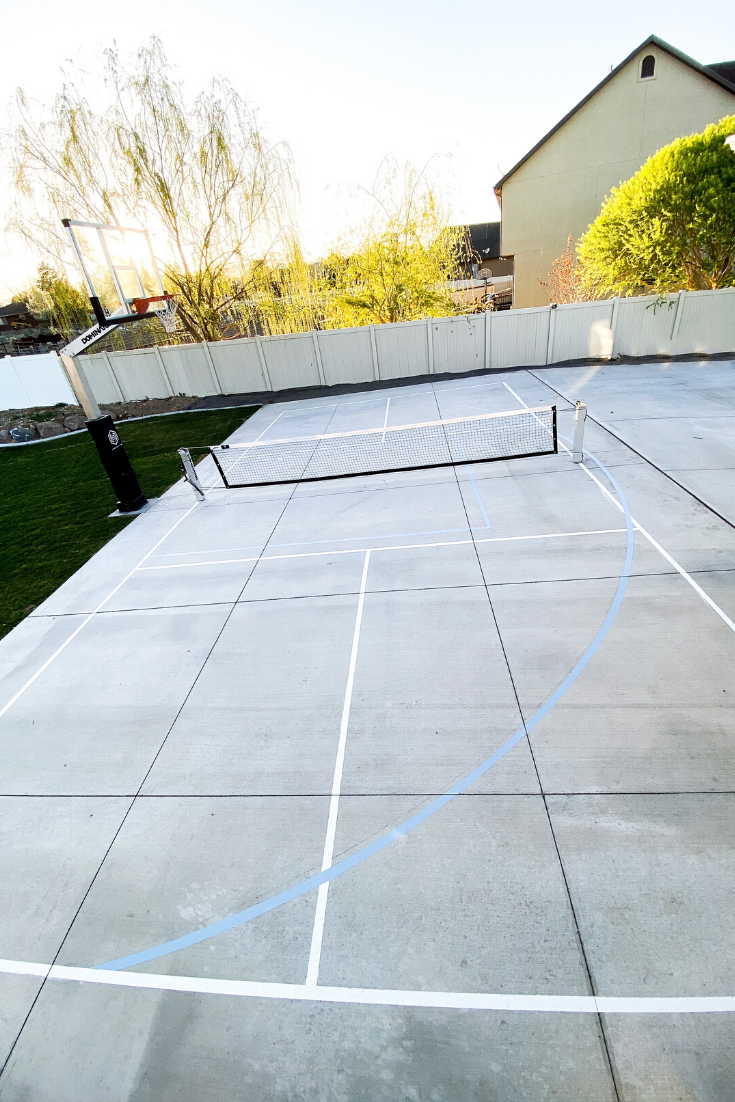
The internet seems to lack any real DIY tutorial on how to mark and line a pickleball court, so I hope this tutorial here finds those in need and answers all the major questions when it comes to creating a concrete painted DIY pickleball court.

Court Dimensions
I will base the tutorial off of a regulation pickleball court, but also show how we customized our dimensions to fit our court.

A regulation pickleball court is 44 feet long from the outside of each white line, and 20 feet wide. The kitchen or non-volley zone is 7 feet wide and spans the distance of the court’s 20 foot width. Each line is 2 inches in thickness and is considered “in” if the ball lands on it which is why the measurements are taken from the OUTSIDE of the white line (as shown in the image above from pickleball fix).
Taping out a Regulation Size Court

The most difficult part to this project is the tedious measuring, chalk lining, and taping out of the lines. The measurements need to be precise otherwise your court will be slanted, crooked, sloping, and not square.
The easiest way I found to conquer the taping of the court is to take it one half at a time, and measure out these specific points before chalking and taping.
- Distance from Post to baseline : 22 feet (half the length of the court).
- Distance from post to across baseline triangle measurement: 29.73 feet or 356.78 inches.
Take a tape measurer and mark where 22 feet and 356.8 inches meet, and that is the outside measurement of your tape line.

Repeat the same thing on the other side as shown below.

Snap a chalk line. You’ll need two people to hold the string in order to snap an accurate chalk line. Each person holds the chalk string at the two end points. The person who has the spool of string will pull the string VERY taut, then raise the string a few inches away from the cement and let go. Boom. Perfect line.
Measure 2 inches into the court and snap a 2nd chalk line. You’ll apply tape along both these chalk lines. I prefer to use frog tape because it’s known to create a more crisp line with less bleed through. You will paint in between the two pieces of tape.

Marking the baseline so it is 22 feet from the center of the court (or 44 feet from the other baseline), Snap a chalk line from sideline to sideline, then snap a 2nd chalk line 2 inches into the court.


Marking kitchen
The kitchen is 7′ from the net, but its easiest to measure 15′ from the baseline into the court and marking two spots right where the arrows are. then snapping a line. Measure 2 inches in again, and snap your 2nd line. Tape these two lines. Are you noticing a pattern yet 😉


Marking Centerline: The centerline separates the backcourt into two services areas. It splits the court in half so measure 9 feet 11 inches from each sideline (the inside of your outer tape). The court is 20 feet wide and the painted line is 2 inches wide.

Marking a Full Pickleball Court.
The steps are similar if you are trying to mark an entire court at the same time instead of half of it at a time. you will need 3 tape measurers, and one must be able to extend 50 feet in order to accurately mark a full pickleball court.
Determine your starting point, mark it, and extend two tape measurers across the length and width of the court. Take a 3rd tape measurer and extend it across the court diagonally 48.3 feet to get your measurements square and straight.


Mark the sidelines 44 feet long, and snap a chalk line. Measure 2 inches INSIDE and snap a 2nd chalk line. Tape along both lines.

Baseline should measure 20 feet from outside chalk line to outside chalk line. Snap chalk line for the baseline, then 2 inches inside the court again for the 2nd chalk line.

Marking the kitchen is the same process has shown above in the half court instructions. Measure from the outside chalk mark into the court 15 feet.

The centerline is 9ft 11inches from the outside chalk line toward the center and only extends from the kitchen to the baseline.

Prepping for paint
Now that your court is covered with tape you’ll want to take a sharp knife and cut away the tape where the lines intersect.
Press the tape down along its seam firmly to create a good seal.

Concrete paint
There are a variety of outdoor paints meant for concrete. I opted to use Sherwin William’s porch and floor enamel since I had used it before and seen success. I’ll let you know how well it works for this line application. I also suggest using a 3″ textured roller meant for concrete/rough surfaces. I did not have one of these on hand due to COVID-19, but I made a 6″ foam roller work.

Apply 3 coats of each paint, pulling the tape off at a diagonal immediately after the 3rd coat. Take into account the type of paint you are using and the outside temperature to make sure it isn’t too hot or too cold for your paint to cure.
Lastly, seal your concrete to help keep the lines in tact and protect your concrete from stains and water.
If you have any questions feel free to DM me on IG @honeybuilthome as well as checkout my highlight bubble: COURT for video footage of the entire process.
xo-
Christine




+ show Comments
- Hide Comments
add a comment